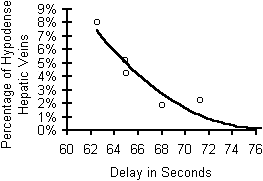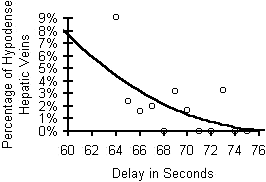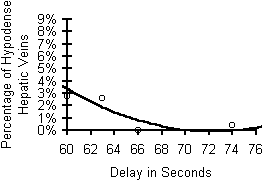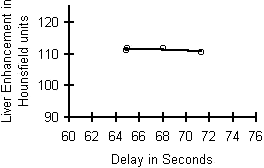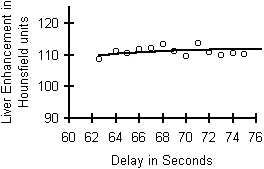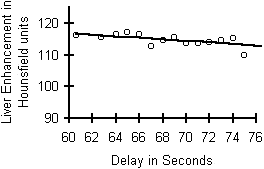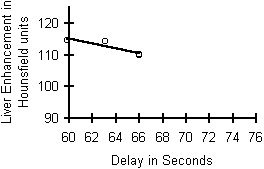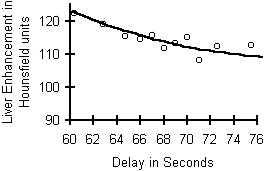Hepatic Veins and Liver Enhancement, Analysis of Scan Delay Timing.
During the portal-venous phase of liver enhancement, it is desirable to achieve peak liver enhancement. It is also desirable to set the scan delay long enough so that the hepatic veins are opacified. Both liver and hepatic veins enhancement are affected by the scan delay. Un-opacified "hypodense" hepatic veins are a potential problem that could cause mis-diagnosis of hepatic veins as metastatic lesions, or could cause small metastatic lesions to be missed. It is therefore important to set the scan delay optimally. Each weight category requires different scan delays, with the heavier patients needing longer scan delays than lighter patients. (see below for justification).
If perfection could be achieved, a 0% incidence of hypodense hepatic veins would be the goal. However if the delays were set long enough to achieve 0%, the liver enhancement would be past peak in some circumstances. Therefore, a compromise goal is to achieve near-peak liver enhancement while keeping the hypodense hepatic veins incidence under 5%.
The time delay at which an incidence of 5%
hypodense hepatic veins occurs, is at different delays for each weight category:
At approximately 65 seconds for the 78-97kg group, at 62 seconds for the
64-77kg group, and at <58 seconds for the 48-63kg group. These delays should be
considered as minimums.
The Enhancement of the liver should be the highest possible, in order to maximize the visual contrast between normal liver and metastases (which are usually hypodense). The graphs below show that scan delay time has little effect on liver enhancement in the 78-97 kg group (heavier patients), whereas there is a definite trend towards higher liver enhancement at earlier scan delays in lighter patients, particularly in the 48-63 kg group.
The extreme lightest and heaviest patient groups are the 38-47 kg and the 98-117 kg groups. These groups have too few patients in each group to allow an accurate trend analysis of their incidence of hypodense hepatic veins. But the data for liver enhancement from these extreme groups, shows the same pattern as the above. The heavier patients benefit from later scan delays, while lighter patients benefit from earlier scan delays.
38-47 kg group |
Scans start at Chest | 98-117 kg group |
Scans start at chest |
|---|---|---|---|
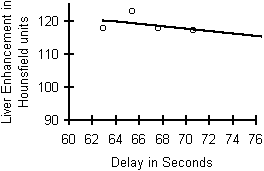 |
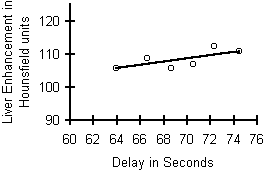 |
||
back to CT parameters per body weight
End of page Navigation links: Halls.md home or Back to top
Copyright © 1999 - present. Steven B. Halls, MD . 1-780-608-9141 . [email protected]
